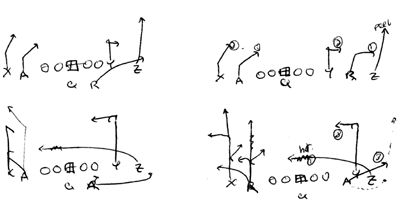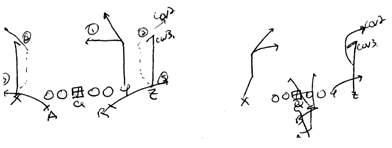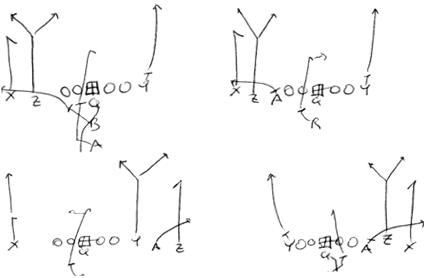No, not a reference to those ubiquitous white undershirts, I'm referring to
"coverage beaters." Uncertainty is a permanent part of playcalling. Even at the Pros, where they have cameras, computers, and all the best playcallers with natural "feel," no one
really knows what is coming next, becauseyou're calling plays against a person, not a computer or a fixed game with certain rules. As Norm Chow has said, a playcaller might look smart in the booth, but he really doesn't know what the other team is going to do, and very often doesn't even know "what the other team just did or is doing." Unfortunately coaches, not only don't you know exactly what is going on, but you have a kid, 16-18 years old, maybe 20-22, whose job it is to figure out what they are doing and make you look smart-- in less than two seconds--while someone tries to remove his jawbone every play.
One of the simplest and best ways to have a good passing attack under uncertainty is to "package" passes to each side of the formation and give the QB a simple "key," which tells him which progression to use. The simplest keys are:
(1) MOFO/MOFC (Middle of the field Open, or closed? I.e. is there a single deep safety down the middle?)
(2) 2-high, 1-high, or none-high (Basically the same as MOFO/MOFC, a simple way to determine coverages); or
(3) the movement/rotation of one defender (usually free safety, strong safety, or middle linebacker).
Then, the QB just goes through his progression of 1, 2, 3 after this. I'll save the mechanics of progression reads for another time, suffice to say that the QB "looks through the window," and basically looks where the receiver is supposed to be, and asks if he has a clear lane to throw him the ball. If not, he moves on to the next receiver.
Basic Concept:The easiest way to do this is as below, as shown from a balanced 4-wide formation and simple 3-step passing routes like hitches, slants, and speed/outs. For example:

The pattern on the left is a great combination. The double slants is very good versus 2-deep 5-under zones, and the slant/shoot is effective vs. 3-deep 4-under zones. Also, typically 3-deep zones play "off" and 2-deep zones play press, so you can pick and choose what "key" to give your quarterback, but they all end up being the same: you want slant/shoot vs. Cover 3; double-slant vs. Cover 2.
Some teams say "If MOFO, work double-slants, if MOFC, work slant/shoot," while others say "Vs. 2-high, double slants; vs. 1-high work slant/shoot." Finally, some even say: "if press, then..." you get the idea. Any of these "keys" will work. It is probably best to figure out which one is the most versatile for what you're doing and do that the most, so your QB is comfortable for it.
Again, the idea is on the blackboard we want one versus "Cover 2" and another vs. "Cover 3" but first, this is a simple way to determine those coverages, since you can't see all eleven defenders, and second, these keys often simplify "cosmetic" changes, i.e. ones where guys switch assignments or do things to trick you, as they reduce a coverage to its simplest terms: how many guys are deep?
The diagram on the right combines the fade/out and double-hitch combination. Again we have options vs Cover 2 (fade/out) and Cover 3 (double-hitch) but more importantly we have a good pass vs. soft (hitches) and press man (fade/out). So now we turn to some of the mechanics for these "keys."
Mechanics of Reading Keys:The QB checks his keys pre- and post-snap.Pre-snap, he scans left to right the defense and coverage. If his key is MOFO/MOFC, he looks down the middle of the field. Is someone standing deep in the middle? Are there two safeties on the hashes? Are the safeties moving? Is
no one deeper than 7 yards? (Blitz!)
At the snap, he looks for "post-snap confirmation." Basically, did what looked like MOFO/Cover 2 turn into MOFC? Commonly, a safety deep on each hash will rotate to the same side--one safety runs to the deep middle, while the other comes up to guard the flat, an inside zone, becomes a "robber" (roving pass defender reading the QB's eyes), will cover a slot receiver man while another defender blitzes, or blitz.
One advantage to keeping your quarterback under center versus the shotgun is he can keep his eyes downfield from the snap without having to look at the ball to catch the snap as in shotgun. Thus, he is less likely to miss something. Particularly for 3-step passing. In the shotgun the quarterback must rely on his pre-snap read, as he does not have time "confirm" after getting the snap, and must begin his progression. In major college football, the best 3-step passing team has been USC, who almost exclusively throws from under center. On the other hand, the best 3-step passing team of the last 9-10 years has been Purdue, who throws 3-step from the shotgun quite a bit, so it can be done and done well.
I prefer to use MOFO/MOFC and 1-high/2-high as much as possible as my keys, rather than press/non-press or certain other ones, because of the mechanics: I like having the QB look down the middle of the field after the snap because (a) it does not give away which side the QB is looking for right away, as we always teach him to look down the middle when he begins his drop, and (2) it is easier and more obvious and often more telling--sometimes individual defenders "do their own thing" and aren't much help in determining what the other 10 guys are doing, and the difference between "press" and "soft" or sometimes even "man or zone" is often subtle and difficult to gauge in 1.5 seconds. Conversely, 2-high or MOFO is usually easier to see, and is thus preferable. Nevertheless, each key has strengths weaknesses and some fit better for different situations.
Other examples -- Man and Zone Beaters:The 3-step game and the spread is the ideal setup for this concept. In fact, I really do not like to run too many "drop-back" passes from spread formations for protection reasons, but you can pick a defense apart if you can throw quicks vs Cover 2 or 3 to the outside and be able to
run the ball inside
in the spread. Below are a couple simple examples for dropback passing.

Besides Cover 2 and Cover 3 beaters, the most useful, to me, is packaging man and zone beaters together. Below are my two favorite versions: stick and double slants, and shallow/curl and a zone-beater backside. These are shown below:

On the top, if the QB sees zone (we can use motion, gameplan, or other keys to determine this) he wants to work the stick, reading flat to stick route. Against man or some kind of weak-blitz, he wants to throw the double slants.
For the patterns below, if he reads man he reads 1-shallow, 2-curl, 3-swing route. Vs. a zone he works the zone beater, such as curl/flat, smash, post/curl, or a 3-step combation. Most of the best passing teams can do this quite a bit and are very good at reading keys and going through the simple progressions. Notice how quick these passes get out--they are designed with the blitz in mind.










